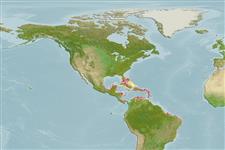Chondrilla caribensis Rützler, Duran & Piantoni, 2007
| Native range | All suitable habitat | Point map | Year 2050 |

|
| This map was computer-generated and has not yet been reviewed. |
| Chondrilla caribensis AquaMaps Data sources: GBIF OBIS |
Upload your photos
Google image |
No photo available for this species.No drawings available for Chondrillidae.
Google image |
No photo available for this species.
Classification / Names Common names | Synonyms | CoL | ITIS | WoRMS
Demospongiae | Chondrillida | Chondrillidae
Environment: milieu / climate zone / depth range / distribution range Ecology
Sessile; brackish; depth range 1 - 2 m (Ref. 86836). Tropical
Distribution Countries | FAO areas | Ecosystems | Occurrences | Introductions
Western Central Atlantic: Caribbean.
Length at first maturity / Size / Weight / Age
Maturity: Lm ? range ? - ? cm
Short description Morphology
Chondrilla caribensis f. hermatypica: shiny mustard to greenish yellow; tough encrustations. Chondrilla caribensis f. caribensis: grayish to reddish brown; thickly encrusting; often lobed (Ref. 82089). Grows in any combination of thick encrusting lumps, pillows, low mounds, sheets, or runners. Surface is shiny, smooth and slippery. External color: combination of yellow brown and greenish to dark brown, sides often paler; cryptic specimens completely pale white or tan. Internal color: cream. Tough consistency. Oscules scattered or on top of pillows or mounds; usually small, flush or indented with a collar that may be elevated or indented (Ref. 85482).
Depth range from Belize and Panama (Ref. 86836). Occurs in shallow hard bottoms. Often attaches to seagrass blades, dead finger coral branches, mangrove prop roots and artificial structures (Ref. 85482).
Life cycle and mating behavior Maturity | Reproduction | Spawning | Eggs | Fecundity | Larvae
Members of the class Demospongiae are hermaphroditic. Life cycle: The zygote develops into parenchymella larva (free-swimming) before settling down on a substrate where it grows into a young sponge.
Main reference
References | Coordinator | Collaborators
Rützler, K., S. Duran and C. Piantoni. 2007. (Ref. 82089)
IUCN Red List Status (Ref. 130435)
CITES status (Ref. 108899)
Not Evaluated
CMS (Ref. 116361)
Not Evaluated
Threat to humans
Harmless
Human uses
| FishSource |
Tools
More information
Internet sources
BHL | BOLD Systems | CISTI | DiscoverLife | FAO(Publication : search) | Fishipedia | GenBank (genome, nucleotide) | GloBI | Gomexsi | Google Books | Google Scholar | Google | PubMed | Tree of Life | Wikipedia (Go, Search) | Zoological Record
Estimates based on models
Preferred temperature
(Ref. 115969): 25.5 - 28.2, mean 27.2 (based on 367 cells).


